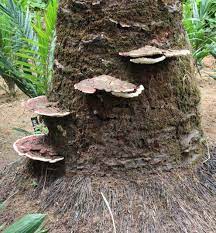27 Jan 2022 Basal stem rot

- Recently, researchers from Kerala have identified two new species of fungi belonging to the genus Ganoderma, which are related to coconut stem rot.
About basal stem rot:
- There are two fungal species Ganoderma keralense and Ganoderma pseudoapplanatum.
- Butt Rot or Basal Stem Rot of Coconut is known by different names in different parts of India: Ganoderma Wilt (Andhra Pradesh), Anabaroga (Karnataka) and Thanjavur Wilt (Tamil Nadu).
- Infection begins at the roots but symptoms include discoloration and rotting of stems and leaves. In the later stages the flower and coconut fruit begins to die and eventually the entire coconut (Cocos nucifera) is destroyed.
- It appears as a reddish brown runny/leaky substance. The presence of this leaky substance has been reported only in India.
- Once infected, the plants are unlikely to recover. It is no wonder that it causes huge losses, according to some estimates done in the year 2017 in India it is said that around 12 million people are dependent on coconut cultivation.
- Another sign of infection is the presence of shelf-like “basidiomata”, which are fungal fruiting or reproductive structures on the trunk of the tree.
Fungi:
- Fungi can be single celled or very complex multicellular organisms.
- They are found in almost any habitat but live mostly on land, mainly on soil or plants rather than sea or freshwater.
- Groups called decomposers grow in soil or on dead plant matter, where they play an important role in the cycling of carbon and other elements.
- Parasites of some plants cause diseases like mildew, scab, scab.
- A small number of fungi cause diseases in animals. In humans these include skin diseases such as athlete’s foot, ringworm and thrush.


No Comments